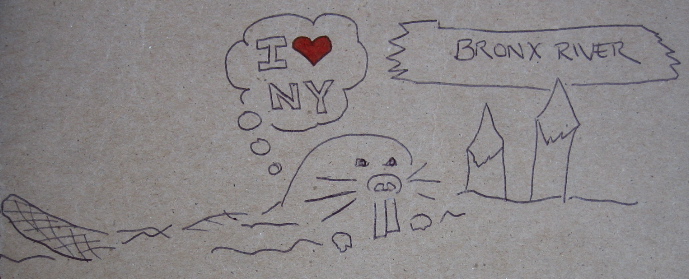The most exciting news about New York City environmental conservation is the report of a wild beaver seen building a nest in the former toxic waste dump of the Bronx River. His mud and stick house was spotted in the river earlier, but it wasn’t until Wednesday, February 21, 2007 that biologists caught the beaver on videotape, thereby confirming his existence. Beaver, once abundant around the Bronx River, were heavily hunted for their fur and have not been seen in the area since the early 1800s.

Since last fall, scientists began monitoring the river after several reports of beaver sightings from residents. Previously dismissed as the more common muskrat, the biologists changed their tune when they discovered a 12-foot-long dirt and twig habitat near gnawed-off trees by the riverbank — this definitely pointed to a beaver. And the actual beaver sighting on Wednesday showed him swimming around looking for more building materials for his growing lodge. The scientists believe the beaver is a young male about two to three years old who is looking for a female partner.
The beaver is named José in tribute to U.S. Representative of the Bronx José Serrano, whose commitment to Bronx River cleanup was cemented with $15 million in government funds.
Beavers are especially meaningful to New York State because they are the official state animal. They appear on the City of New York’s official flag twice as well as on the official state seal.
Bronx River woes
The history of the beaver trapping along the Bronx River began in the early 1600s when Europeans came to the area, then known by the Mohegan Indian name Auqehung. The river soon became an industrial mill zone, the water powering several plants such as paper and flour mills. Jonas Bronck was the mastermind behind the mills; after buying some 500 acres of land from the Native Americans, soon the river was known as “Bronck’s River.” By the early 1800s, when the last beaver was sighted, the river area was still an ecological wonder with thick forests and pristine drinking water. However, by the mid-1800s, the river changed into an industrial waste zone and its degradation would continue until the 1970s. The Bronx River Restoration Project began in 1974 to begin the cleanup that 33 years later led to native species like the beaver returning. Organizations like the Bronx River Alliance lead the way for environmental protection of the river.
Beavers are vital for the environment
Beavers create sustainable habitats that are essential for surrounding flora and fauna alike. They naturally prune and rid areas of foliage and, in doing so, create a thriving environment for the leftover vegetation. The dams they build create a natural filter, slow erosion, and build wetlands for birds and reptiles. Beavers also naturally regulate their population by breeding only once a year and instinctively know when to have more or less babies, called kits. For more about these critters, click here.
Environmental cleanup does have substantial success as evidenced in this case of the first beaver to be spotted in the Bronx River in 200 years. The rewards and environmental benefits that native species bring to an ecological area are so positive that, by changing our polluting habits, we are also greatly improving our own lives.
keeping the earth ever green
- Follow us on Twitter: @inthefray
- Comment on stories or like us on Facebook
- Subscribe to our free email newsletter
- Send us your writing, photography, or artwork
- Republish our Creative Commons-licensed content

